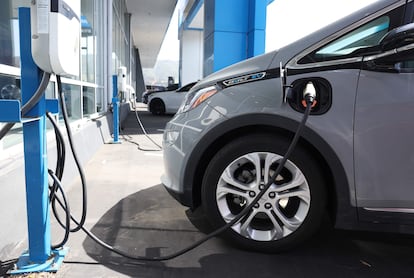General Motors delays electric pickup truck production at plant near Detroit as US EV demand slows
GM spokesman Kevin Kelly said the change has nothing to do with the ongoing four-week partial strike by members of the United Auto Workers union

General Motors will delay electric pickup truck production at a factory near Detroit due to slowing U.S. demand for electric vehicles, to better manage its capital investments, and to make some engineering changes. The company said in a statement Tuesday that the factory in Orion Township, Michigan, will instead start making electric Chevrolet Silverado and GMC Sierra pickups in late 2025. Originally the company had planned to start production sometime next year.
GM spokesman Kevin Kelly said the change has nothing to do with the ongoing four-week partial strike by members of the United Auto Workers union. “What’s happening in the marketplace does play a factor,” said Kelly, who added that the company wants to make engineering changes that will improve the trucks’ profitability.
About 1,000 workers at the Orion plant will keep building the Chevrolet Bolt hatchback small electric car and Bolt electric utility vehicle through the end of this year as planned, the company said in a statement. Workers will be offered positions at other Michigan factories until their plant reopens, the statement said.
GM already is building a Chevrolet Silverado work truck at its “Factory Zero” electric vehicle plant, which straddles the border between Detroit and the enclave of Hamtramck. The plant also makes the GMC Hummer EV as well as the Cruise Origin, a multi-passenger electric ride-hailing shuttle. GM says it’s still planning to ramp up production at Factory Zero next year, including adding a second shift.
Demand for electric vehicles in the U.S. has started to level off after a couple of years of huge growth. In August, for example, automakers sold almost 111,000 EVs, equating to 8.3% of the total market. But in September, sales dropped to just under 106,000, or 7.9% of the market. August EV sales were up almost 60% from a year earlier, but in September, the year-over-year growth rate dropped to 56%, according to Motorintelligence.com.
U.S. dealers had an 88-day supply of new EVs at the end of September, compared with the industry as a whole, which had a 56-day supply, according to data from Kelley Blue Book. The average price of an EV was just over $61,000 in January, but that fell to just under $51,000 in September. That’s because of large price cuts by market leader Tesla and increased production and sales of the lower-cost Chevrolet Bolt.
Sam Fiorani, an analyst with AutoForecast Solutions, a consulting firm, says EV inventory is growing and prices are falling as demand levels off.
“We’re transitioning between early adopters and regular vehicle buyers, so the appeal is different,” he said. “Education is required to let them know that these are real vehicles as well. But that transition is a lot more difficult and takes more time.” Still, Fiorani predicted that EV sales growth won’t recede much, but the rate of increase won’t be as high as it was previously.
The U.S. government is offering up to a $7,500 tax credit for those who buy or lease EVs. Next year eligible buyers will be able to get the credit at the time of purchase rather than waiting until they file their income tax returns.
Sign up for our weekly newsletter to get more English-language news coverage from EL PAÍS USA Edition
Tu suscripción se está usando en otro dispositivo
¿Quieres añadir otro usuario a tu suscripción?
Si continúas leyendo en este dispositivo, no se podrá leer en el otro.
FlechaTu suscripción se está usando en otro dispositivo y solo puedes acceder a EL PAÍS desde un dispositivo a la vez.
Si quieres compartir tu cuenta, cambia tu suscripción a la modalidad Premium, así podrás añadir otro usuario. Cada uno accederá con su propia cuenta de email, lo que os permitirá personalizar vuestra experiencia en EL PAÍS.
¿Tienes una suscripción de empresa? Accede aquí para contratar más cuentas.
En el caso de no saber quién está usando tu cuenta, te recomendamos cambiar tu contraseña aquí.
Si decides continuar compartiendo tu cuenta, este mensaje se mostrará en tu dispositivo y en el de la otra persona que está usando tu cuenta de forma indefinida, afectando a tu experiencia de lectura. Puedes consultar aquí los términos y condiciones de la suscripción digital.
More information
Archived In
Últimas noticias
Mexico seeks to shore up its defenses following US incursion in Venezuela
Hope gives way to uncertainty among Venezuelan exiles in the US after Maduro’s capture
Cubans look to Venezuela fearfully after Trump’s incursion: ‘We could be next’
The operation in Venezuela to capture Maduro threatens to widen the cracks in the MAGA movement
Most viewed
- Alain Aspect, Nobel laureate in physics: ‘Einstein was so smart that he would have had to recognize quantum entanglement’
- Alvin Hellerstein, a 92-year-old judge appointed by Bill Clinton, to preside over Maduro’s trial in New York
- Gilles Lipovetsky: ‘If you want to live better and fall in love, take Prozac, don’t look to philosophy’
- Cuba confirms death of 32 of its citizens in the US attack against Venezuela
- Why oil has been at the center of Venezuela-US conflicts for decades










































